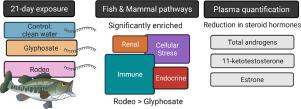Aquatic Toxicology ( IF 4.1 ) Pub Date : 2022-03-12 , DOI: 10.1016/j.aquatox.2022.106142 Maite De Maria 1 , Kevin J Kroll 1 , Fahong Yu 2 , Mohammad-Zaman Nouri 1 , Cecilia Silva-Sanchez 1 , Juan Guillermo Perez 1 , David A Moraga Amador 2 , Yanping Zhang 2 , Mike T Walsh 3 , Nancy D Denslow 4

|
Glyphosate is the most used herbicide worldwide, with no historical comparison. It is used for genetically modified crops, and particularly in Florida, it is used as a sugar cane ripener. An aquatic formulation (Rodeo®) is used to treat aquatic weeds in waterbodies and drainage canals. Because of its extended use, glyphosate can run off or be sprayed directly into waterbodies, and chronically expose aquatic wildlife. Exposure in animal models has been associated with kidney and liver damage and glyphosate has been suggested as an endocrine disruptor. We exposed adult male largemouth bass for 21 days to two doses of glyphosate and Rodeo® (chemically equivalent concentration of glyphosate) at 0.5 mg L−1 and 10 mg L−1 and to a clean water control (n=4 fish/tank in quadruplicate). Concentrations during the experiment were corroborated with UHPLC-MS/MS. Total RNA was isolated from the trunk kidney and head kidney. RNA-seq was performed for the high doses compared to controls. Transcripts were analyzed with fish and mammalian pathway analyses software. Transcripts mapped to Zebrafish metabolic pathways using PaintOmics showed steroid hormone biosynthesis in the trunk kidney as the most significantly enriched pathway. Steroid hormones were measured in plasma by UHPLC-MS/MS. Total androgens were significantly reduced at 0.5 mg L−1 of glyphosate and at equivalent concentrations in Rodeo® compared to controls. 11-ketotestosterone and estrone concentrations were significantly reduced in all doses. A gene involved in the conversion of testosterone to 11-ketotestosterone was down-regulated by glyphosate. Using the mammalian pathway analysis algorithm, cellular processes associated with T-cell activation/development and intracellular pH were significantly enriched in the trunk kidney by glyphosate and Rodeo® exposure. Endocrine disruption was corroborated at the hormone and gene expression levels. Rodeo® and glyphosate share gene expression pathways, however, Rodeo® had more pronounced effects in largemouth bass.
中文翻译:

长期接触草甘膦和 Rodeo® 后雄性大口黑鲈的内分泌、免疫和肾毒性
草甘膦是全世界使用最广泛的除草剂,没有历史比较。它用于转基因作物,特别是在佛罗里达州,它被用作甘蔗催熟剂。水生制剂(Rodeo®)用于处理水体和排水沟中的水生杂草。由于其长期使用,草甘膦可能会流失或直接喷洒到水体中,并长期暴露于水生野生动物中。动物模型中的暴露与肾脏和肝脏损伤有关,草甘膦被认为是一种内分泌干扰物。我们将成年雄性大口黑鲈暴露于两种剂量的草甘膦和 Rodeo®(草甘膦的化学当量浓度)(草甘膦的化学当量浓度)(分别为 0.5 mg L -1和 10 mg L -1 )以及干净的水对照(n = 4 条鱼/鱼缸,一式四份)。实验期间的浓度通过 UHPLC-MS/MS 得到证实。从躯干肾和头肾中分离出总RNA。与对照相比,对高剂量进行了 RNA 测序。使用鱼类和哺乳动物途径分析软件对转录本进行分析。使用 PaintOmics 映射到斑马鱼代谢途径的转录本显示,躯干肾脏中的类固醇激素生物合成是最显着富集的途径。通过 UHPLC-MS/MS 测量血浆中的类固醇激素。与对照相比,在 Rodeo® 中,0.5 mg L -1草甘膦和同等浓度的总雄激素显着降低。所有剂量的 11-酮睾酮和雌酮浓度均显着降低。草甘膦下调了参与睾酮转化为 11-酮睾酮的基因。 使用哺乳动物途径分析算法,通过草甘膦和 Rodeo® 暴露,与 T 细胞激活/发育和细胞内 pH 相关的细胞过程在主干肾中显着富集。内分泌干扰在激素和基因表达水平上得到证实。 Rodeo® 和草甘膦具有相同的基因表达途径,但 Rodeo® 对大口黑鲈的影响更为明显。









































 京公网安备 11010802027423号
京公网安备 11010802027423号